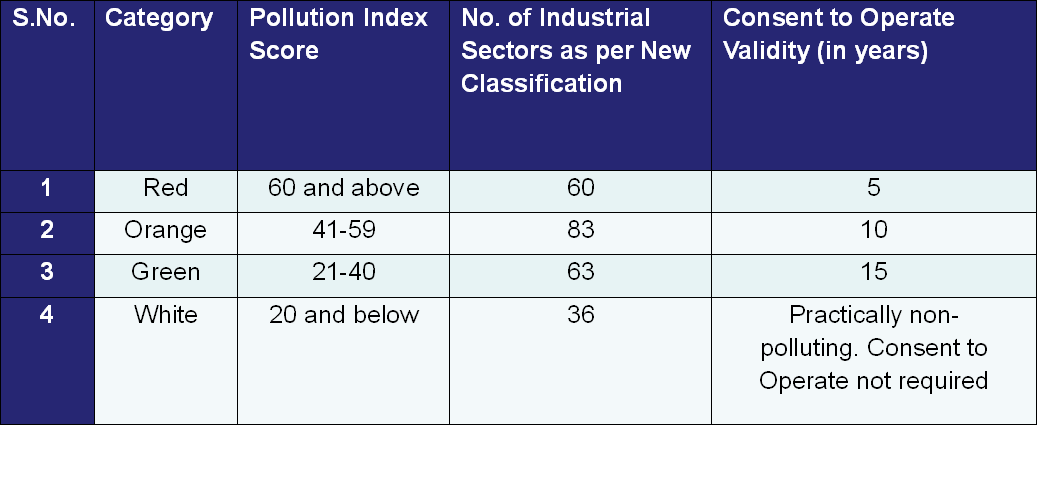India: New Classification for Consent Management
Jun 13th, 2016 | By Pranav Sinha / Shweta Arora | Category: Environmental Management, India
The Central Pollution Control Board (CPCB), the environmental regulator at the federal level in India, issued “Modified Directions” to the State Pollution Control Boards (SPCBs) and the Pollution Control Committees (PCCs) (the state-level regulators) on 07 March 2016, for what it terms the “harmonization” of the classification of industrial sectors for consent management across the States and Union Territories (UTs) of India.
Background
A classification of industries had already been in place, introduced by the CPCB through the Directions issued under the Water Act, 1974, in 2012. However, this was not being strictly adhered to by the SPCBs and PCCs. Instead, the SPCBs and PCCs had been following their own criteria for classification of industrial sectors for consent management and surveillance of industries. With very little harmonization existing between classification of industries across different States of India, industries were forced to meet varied sets of regulatory requirements for the same or similar operations located in different States.
What’s Changed and Why This Will Work
The new classification is based on more robust scientific logic and is industry friendly. It is expected to reduce the administrative burden of compliance for the industries.
With the Modified Directions issued on 07 March 2016 being a part of a flagship initiative of the Government of India to promote what is also referred to as the “ease of doing business” in the country, it is expected that this new classification would be adhered to more diligently by the States. That this is a part of the current federal government’s efforts to facilitate setting up and operating businesses, especially manufacturing operations, within India is clear. Listed below are key steps initiated in this regard.
A new category (named “White”) has been added to the classification scheme to include industry sectors that have minimal pollution load (i.e., pollution index score between 1 and 20). Some industrial sectors have been reclassified and moved across categories. The idea behind the re-classification is to categorize an industrial sector considering its potential to cause pollution and not just its size and location, as was the basis earlier.
The validity period of Consent to Operate (hereinafter “CTO”), the key environmental permit, has been increased for all categories of industries. It is important to note that for the industries in the White Category (with a PI score equal to or lower than 20) that are considered practically non-polluting, the government has waived the requirement to obtain a CTO under the Water Act, 1974, or the Air Act, 1981, thus introducing for the first time in India a pollution potential-based threshold for environmental permitting.
New Criteria for Classification
The earlier classification was primarily based on the size of the industries; factors such as pollution due to discharge of emissions and effluents while the possible impacts of the arising pollution on environment were not considered as criteria. The criteria for new classifications are based on the quality of emissions and effluents and hazardous wastes generated, thereby considering the potential of the pollutants to impact the environment.
The Modified Directions classify the industrial sectors using the “Pollution Index” as the criterion. Pollution Index (PI) is a function of air emissions, effluents, and hazardous wastes generated where air emissions and effluents have a weight of 40% each while hazardous waste generated contributes 20% to the value of an industry’s PI. The values of PI range from 0 to 100, with increasing index values based on the pollution potential of an industrial sector.
Table 1 below provides a summary of the new classification categories, number of affected industry sectors for each category, and time period for which Consents would be granted.

Table 1: Industry Categories, PI Scores, and Consent Validity Periods
With a new criterion for classification, the industrial sectors have now been split or merged based on use of raw materials, manufacturing process adopted, and pollutants expected to be generated causing the number of industrial sectors in each category to change.
The Red category that earlier had 85 sectors under it now has 60, while those in the Orange category have increased from 73 to 83 under new classification. The number of industries in the Green category has decreased from 86 to 63. The newly introduced White category comprises 36 sectors. A study of the industries listed in various categories reveals that 26 industry sectors have moved from Red to Orange; 3 from Red to Green; 19 from Orange to Green; 6 from Green to Orange; 2 from Orange to White and 34 from Green to White.
Next Steps
The CPCB issued these Modified Directions on 07 March 2016 and has directed the SPCBs and PCCs to take the following actions:
- Adopt the new categorization of industrial sectors and process all pending and new applications for Consent to Establish and Consent to Operate using the new categorization and criteria.
- Make any further addition of new or remaining industrial sectors and categorize unclassified sectors by using the criteria and guidelines provided with the Modified Directions document. CPCB concurrence is not required except in special cases (“…no concurrence of CPCB shall normally be required….”).
Potential Risks
Potential risks that the government should recognize as it moves towards implementing this new classification include the following.
- Currently the procedure for granting a CTO requires industrial units to be inspected by the SPCB/ PCC before a decision to grant or renew the CTO is arrived at. Industries that are classified under the White category are not required to obtain CTO from SPCB, which may allow them to escape an inspection from the regulator. This in turn, may tempt some industries to misrepresent the nature of their raw materials, fuels, emissions to air, effluent discharges, and waste generation in order to derive the benefit of being classified under the White category.
- As mentioned earlier, grant and renewal of the CTO is one of the key triggers for regulatory inspections by SPCB and PCC in the present system. With the doubling of the CTO validity period for all categories (apart from White), the inspection frequency may get halved, further reducing ground-level enforcement of environmental regulations. This loophole can be closed by delinking inspection frequency from the process used for granting and renewing CTOs. Instead, inspections could be carried out periodically for all industrial units depending upon the nature of the industry and other local factors.
Closing
The expected impacts of the reclassification are many. While the reclassification is part of the broader initiative to facilitate setting up and operating new businesses in India, it also aims to create a more consistent and efficient mechanism for managing the key environmental permit (CTO), across the country. This move will also significantly reduce the administrative burden on the regulators (SPCBs and PCCs), allowing them to focus their resources and time more effectively on the most polluting industries, while not losing time over relatively cleaner operations.
With the regulatory permitting burden on the industries having been made directly proportionate to their pollution potential, this approach will provide a further direct incentive to groups or sectors of industries to adopt less harmful raw materials, renewable and alternate sources of energy, cleaner technologies of production, and more efficient treatment mechanisms for air emissions, wastewater discharge, and hazardous wastes. These changes would allow a potential reduction in the industry’s PI score, potentially allowing their industrial sector to be reclassified to a less-polluting category (thereby, increasing the period of validity for CTO obtained by them).
This effort once again underlines the shift in government policy from the traditional bureaucratic “command and control” approach (that was often alleged to be largely adversarial to and suspicious of industry), to a pragmatic, risk-based approach towards effective governance.
By increasing the period of validity for Consents (thus reducing the frequency of permit renewals), it reduces the administrative burden on both industries and the regulatory agencies, which have long complained of a severe shortage of resources.
About the Authors
Pranav Sinha, AIEMA, PEA, is a Principal Consultant with Environmental Resources Management (ERM) in New Delhi, India. He has more than 12 years of experience in EHS and social consulting, and presently leads the audits, regulatory support, asbestos, and product stewardship services within ERM’s Indian business unit. Pranav has performed over 350 assignments, providing EHS and social advisory support to more than 100 multinational clients across 12 countries.
Pranav has a deep understanding of Indian EHS & social legislations. He also has knowledge of the EHS legislation of Pakistan, Sri Lanka, and Egypt and has significant experience and sound knowledge of EHS due diligence and liability assessments, supply chain audits, pharmaceutical supply chain initiative (PSCI), BSR Standards, EICC Code of Conduct, IFC Performance Standards, and GRI Guidelines for Corporate Reporting.
Pranav holds a B.Sc. in Environmental Science from the University of Delhi. He also holds a M.Sc. in Environmental Impact Assessments, Auditing & Management Systems from the University of East Anglia, Norwich. He is an Associate of the Institute of Environmental Management & Assessment (IEMA), UK and a registered Principal Environmental Auditor.
Shweta Arora is presently working at Delhi Pollution Control Committee. She is involved in providing regulatory oversight for pollution control in Delhi, including conducting inspections, processing applications for environmental permits, responding to applications from the public under the Right to Information Act, and handling complaints made against polluting industries. In the past year, she has inspected more than 100 industries in Delhi for pollution control norms. Shweta previously worked with Toxics Link, an environmental NGO focused on e-waste in India.
Photograph: Brindavan Gardens in Mysore, India by Pranav Sinha, New Delhi, India.
Return to the EHS Journal Home Page


[…] India: New Classification for Consent Management […]